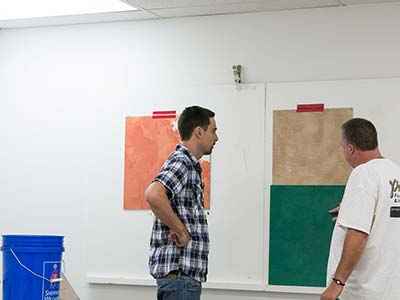Decorative Painting Techniques & Textures
 Enhancing the aesthetic appeal of a home can be done in many ways. You can introduce new fixtures, window treatments, and add furniture pieces. One efficient way to give your home a fantastic new look is to make use of decorative paints. Repainting the house using decorative techniques and textures achieve dramatic effects in living and dining rooms, kitchens or home offices. Decorative painting is a technique that requires skills and knowledge, and the best way to learn this craft is to invest in decorative painting training courses.
Enhancing the aesthetic appeal of a home can be done in many ways. You can introduce new fixtures, window treatments, and add furniture pieces. One efficient way to give your home a fantastic new look is to make use of decorative paints. Repainting the house using decorative techniques and textures achieve dramatic effects in living and dining rooms, kitchens or home offices. Decorative painting is a technique that requires skills and knowledge, and the best way to learn this craft is to invest in decorative painting training courses.Picasso School of Faux Painting & Venetian plastering offers classes that include decorative painting techniques and textures. Whether you are an artist, custom house painter, interior designer, faux finisher or decorator, our class instructors can train you to create expertly finished surfaces that showcase your decorative painting prowess. Our course locations are based in North Palm Beach, FL, but we are open to all those who are interested in learning decorative painting, whether for personal or professional purposes. Please inquire now by calling 954-397-3107 North Palm Beach FL.
Various Decorative Painting Techniques
There are different textures and effects that you can accomplish by applying various decorative painting techniques. These techniques will make any surface, walls, or ceilings look more unique and eye-catching while mimicking expensive materials such as marble, leather or wood.Here are some of the decorative painting techniques and textures that you can use in your project:
- Sponging: A widely used and easiest decorative technique you can learn to add color and texture to any room. It uses natural sea sponge, two to three paint colors, and a glaze. This is applied to bathrooms, kitchens, living rooms, and bedrooms.
- Stenciling: A common decorative painting technique that can transform dull surfaces to more artistic, abstract forms. It can be used for walls, borders, ceilings, and even chair rails.
- Marbleizing: Layers of tinted glazes are placed over a base coat to assemble the look of real marble. This technique can be used for walls, tabletops, fireplaces, and even picture frames.
- Antiquing: It uses earth-hued glazes placed over a yellow or cream-tinted base coat. Great for cabinets, furniture, and tables that you want to have an antiquated look.
- Wood Graining: A technique used for centuries that replicates the appearance of wood. This can be applied to furniture and doors.
- Crackling: This technique uses two paint colors (of your choice), a crackle medium, and a varnish. This creates a dramatic, "countrified" effect on any selected surface, such as a chair, door or table.
- Color Washing: Also called as a broken finish technique, it makes surfaces look timeworn. Use translucent glaze over a contrasting base coat applied with feathery brush strokes for a soft, plumed texture on kitchens, bedrooms, dens, and living rooms.
Apply the Techniques like a Pro
Decorative painting is both science and art, so you must learn the decorative painting techniques and textures only from the experts. Balancing correct tint combinations, texture color schemes, design patterns, and the use of other elements can make a space or surface look alive and dazzling. This is why it is important to learn every detail of a specific technique. The best thing to do is enroll in a faux painting school, where these techniques are learned and applied through quality preparation and execution."MORE ARTICLES"
Faux Painting Classes
Faux Finishing Classes
Venetian Plaster Classes
Venetian Plastering Products
Faux Painting Products


